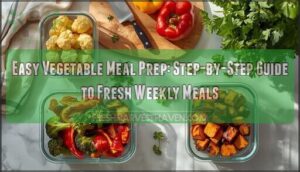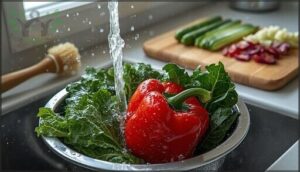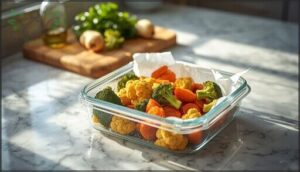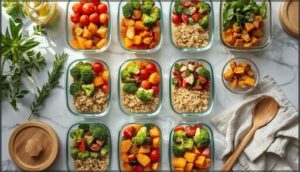This site is supported by our readers. We may earn a commission, at no cost to you, if you purchase through links.
You open your fridge on Sunday night, and there they are: colorful containers of roasted vegetables, chopped peppers, and leafy greens ready to grab. No scrambling for dinner ideas. No wilted spinach wasting away in the back corner. Easy vegetable meal prep transforms chaotic weeknight cooking into a simple assembly line.
The trick isn’t about spending hours in the kitchen—it’s about choosing the right vegetables, prepping them efficiently, and storing them so they stay fresh all week. Once you nail down a few core techniques, you’ll have nutritious meals ready in minutes, not hours.
Table Of Contents
- Key Takeaways
- Choosing Vegetables for Easy Meal Prep
- Step-by-Step Vegetable Prep Techniques
- Simple and Nutritious Vegetable Meal Prep Recipes
- Storing and Organizing Prepared Vegetable Meals
- Time-Saving Tips and Reducing Food Waste
- Frequently Asked Questions (FAQs)
- How can I add more flavor to prepped veggies?
- What are safe reheating methods for vegetables?
- Can I freeze prepped vegetables without losing quality?
- How do I meal prep for special diets?
- What are budget-friendly tips for vegetable meal prep?
- How do I reheat vegetable meals without overcooking?
- Can I meal prep vegetables for specific diets?
- What kitchen tools speed up vegetable meal prep?
- How do I add variety to repetitive meals?
- Should I season vegetables before or after storage?
- Conclusion
Key Takeaways
- Choose sturdy vegetables like root crops and cabbage that last all week in storage, while frozen options lock in nutrients right after harvest and reduce waste by 68% compared to fresh produce that sits around.
- Prevent soggy leftovers by letting cooked vegetables cool 30-60 minutes before sealing containers, lining them with paper towels to absorb moisture, and storing dressings separately until you’re ready to eat.
- Batch cook using three core methods—roasting caramelizes natural sugars at 420°F, steaming retains the most nutrients in 3-10 minutes, and sautéing builds quick flavor for weeknight sides.
- Season vegetables after storage instead of before because salt pulls moisture from produce and causes faster spoilage, so add your herbs and spices during reheating for better flavor and texture.
Choosing Vegetables for Easy Meal Prep
The foundation of any successful meal prep starts with choosing the right vegetables. Some veggies hold up beautifully all week, while others turn soggy by day two.
Let’s look at which vegetables work best for your prep routine, how to spot the freshest options, and when convenience products can actually save you time.
Best Vegetables That Last All Week
Root vegetables like carrots, potatoes, and beets are your meal prep MVPs—they can last months when stored properly in cool, dark spots. Cabbage stays crisp for weeks in your fridge, while frozen vegetables offer year-round convenience without sacrificing nutrition.
One key benefit is that it saves time weekly by prepping vegetables in advance. Skip ethylene-producing peppers and tomatoes near sensitive produce.
These adaptable vegetable choices form the backbone of stress-free weekly meal prep.
Tips for Selecting Fresh, High-Quality Produce
Now that you’ve got your long-lasting vegetables picked out, let’s talk about spotting the best ones at the store. Visual indicators matter—look for bright colors and firm texture without soft spots. Seasonal sourcing gives you peak nutrition, while physical inspection helps you avoid blemishes or wilting. Vibrant colors often indicate freshness and ripeness.
- Check that leafy greens feel crisp, not limp
- Press gently to test firmness in tomatoes and eggplants
- Smell produce near the stem for freshness cues
Using Frozen and Pre-Cut Vegetables for Convenience
If fresh vegetables aren’t always your thing, frozen and pre-cut options can be your secret weapon. Frozen vegetables lock in nutrition right after harvest—sometimes more than fresh produce sitting around for days. You’ll save time skipping all that washing and chopping, plus frozen packs waste less since 68% of people rarely toss them out.
Frozen and pre-cut vegetables lock in nutrition, save prep time, and waste less than fresh produce sitting for days
| Frozen Nutrition | Pre-cut Savings |
|---|---|
| Retains vitamins & minerals | No washing required |
| Quick-frozen at peak ripeness | Ready in 4-5 minutes |
| Longer shelf life | Multiple meal portions |
| Reduces food waste | Budget-friendly option |
| Great backup solution | Simplifies meal prepping |
Pre-cut vegetables for meal prepping cut your prep time in half. Product innovation means you can grab stir-fry blends or seasoned mixes that make easy vegetarian meal prep almost simple. Stock a variety of meal prep vegetables in your freezer, and you’re always ready to throw together a quick bowl or soup without the stress.
Step-by-Step Vegetable Prep Techniques
The way you prepare your vegetables makes all the difference between crispy, vibrant meals and sad, soggy leftovers. Proper washing, chopping, and cooking techniques help lock in nutrients and extend freshness throughout the week.
Let’s break down the essential methods that’ll transform your meal prep game.
Washing and Chopping for Maximum Freshness
Clean water is your best friend for washing techniques for meal prep vegetables. Rinse produce under cool running water—no soap needed—and scrub firm items like cucumbers with a vegetable brush. This simple step removes dirt and pesticides while protecting nutrient retention.
For leafy greens, swish gently in a bowl. Dry thoroughly before chopping methods, since moisture accelerates spoilage and impacts freshness throughout the week.
Preventing Soggy or Wilted Veggies
After all that washing and chopping, you don’t want your veggies turning to mush. Smart vegetable storage tips keep your efforts from going down the drain. The secret lies in controlling moisture—the enemy of crisp, ready-to-eat produce.
- Let cooked veggies breathe. Cooling techniques matter—wait 30 to 60 minutes before sealing containers to avoid trapped steam
- Line containers with paper towels as natural moisture absorbers
- Undercook slightly for a crisp-tender finish after reheating
- Store separate dressings until you’re ready to eat
- Use minimal oil—about one tablespoon per batch prevents greasy sogginess
These food storage techniques transform how your meals hold up through the week.
Batch Cooking Methods (Roasting, Steaming, Sautéing)
Three cooking methods reshape your batch cooking game. Each brings unique strengths to vegetable preparation—roasting caramelizes natural sugars, steaming locks in nutrients, and sautéing builds quick flavor profiles.
| Method | Best For | Cooking Times |
|---|---|---|
| Roasting (420°F) | Root veggies, cauliflower | 30–60 minutes |
| Steaming | Broccoli, leafy greens | 3–10 minutes |
| Sautéing | Quick weeknight sides | 5–10 minutes |
Nutrient retention is highest with steaming, while roasted veggies deliver an unbeatable texture comparison. In terms of energy efficiency, steaming wins for speed, but roasting accommodates 8–12 servings effortlessly—perfect for sautéed vegetable dishes throughout your week.
Simple and Nutritious Vegetable Meal Prep Recipes
Now that you’ve prepped your vegetables, it’s time to put them to work in real meals you’ll actually want to eat. The recipes below cover breakfast, lunch, and dinner—each one designed to save you time without sacrificing flavor or nutrition.
You’ll find simple options that hold up well in the fridge and reheat beautifully throughout the week.
Make-Ahead Breakfasts With Vegetables
Starting your day with vegetables may sound unconventional, but you’ll gain significant breakfast vegetable benefits when you prep protein-packed scrambles with spinach, peppers, and mushrooms.
These vegetarian breakfast recipes draw inspiration from global breakfast flavors—think Mediterranean frittatas or Asian-inspired tofu scrambles.
Use convenient frozen veggies to save time, or experiment with fermented breakfast veggies like kimchi for gut health.
These makeahead meals and vegetarian meal prep ideas simplify your mornings while boosting nutrition.
Grain and Veggie Bowls for Lunch
Grain bowls turn meal prep into an art form—stack quinoa or farro with roasted broccoli, kale, and chickpeas for a lunch that delivers 10 grams of protein and 42% of your daily fiber.
Mix flavor combinations like tahini-lemon or spicy peanut dressing, then add nuts for crunch.
These vegetarian meal prep recipes master portion control while keeping healthy recipes exciting all week.
One-Pan and Sheet Pan Dinners
Sheet pan dinners free you from kitchen duty—toss Brussels sprouts, sweet potatoes, and bell peppers at 400°F for 35 minutes, and you’ve got four days of nutritious meals that 65% of home cooks swear by.
- Use root vegetables first, delicate ones last
- Store oven roasted vegetables up to 4 days
- Reheat at 350°F to maintain texture
- Mix combinations for variety all week
- Boost plant-based sheet pan meal ideas
Hearty Soups, Stews, and Fresh Salads
A steaming bowl of lentil soup contains 150 calories and packs 3 grams of protein, making it perfect for vegetarian meal prep recipes. These easy vegetarian meals offer serious prep efficiency: batch-cook soups in under 30 minutes, and stews with 20% higher popularity can be stored for five days without significant nutrient loss.
| Meal Type | Prep Efficiency |
|---|---|
| Hearty Soups | Under 30 minutes batch cooking |
| Veggie Stews | 5-day storage, minimal nutrient loss |
| Fresh Salads | 90% vitamins retained for 3 days |
Salads provide essential vitamins like A, C, and K while supporting weight management through their low energy density. Notably, 23% of adults rely on them daily, contributing to their popularity alongside stews and soups.
Storing and Organizing Prepared Vegetable Meals
You’ve prepped all your vegetables and cooked your meals—now the real trick is making them last. The way you store and organize everything determines whether you’re eating fresh, crisp food all week or tossing out soggy leftovers by Wednesday.
Let’s cover the essentials: picking the right containers, portioning things out smart, and keeping delicate greens from turning into mush.
Choosing The Right Meal Prep Containers
Your meal prep containers make or break your vegetable storage success. Glass containers are your best bet—they’re airtight, keep food fresh longer, and won’t hold onto flavors or chemicals. Look for BPA-free, microwave-safe options that fit your portioning sizes.
Reusable containers with solid seals protect your veggies from air exposure while supporting sustainability. The right food storage techniques start with choosing containers that actually work.
Portioning, Labeling, and Dating Meals
Once you’ve chosen your containers, proper portioning and labeling keep your week on track. Aim for about half your container filled with vegetables—roughly 2½ cups daily—to boost nutrient intake while controlling calories naturally.
Here’s your simple system:
- Portion by plate sections using visual guides instead of scales
- Label with prep date and use-by date on water-resistant stickers
- Note ingredients and allergens to prevent confusion and support food safety
This method cuts waste and keeps meals fresh.
Storing Leafy Greens, Herbs, and Delicate Produce
Leafy greens need special attention. Rinse them well, pat dry, and wrap loosely in a clean tea towel before sealing in glass containers—they’ll stay crisp up to a week. Store hardy greens like kale in your crisper drawer with humidity control set high.
Keep herbs fresh by placing stems in water like a bouquet, covered loosely.
Ethylene sensitivity matters too: store delicate produce away from ripening fruits to prevent early wilting and waste reduction.
Time-Saving Tips and Reducing Food Waste
Meal prep doesn’t have to eat up your whole Sunday, and you shouldn’t toss out half your produce by Friday either.
A few smart strategies can cut your kitchen time in half while stretching your grocery budget further.
Here’s how to work smarter, waste less, and make meal prep fit into real life.
Efficient Batch Cooking and Planning
You’ve probably realized that cooking everything on Sunday afternoon beats scrambling for dinner at 8 PM on Wednesday. Batch cooking turns a few focused hours into meals for the entire week. Here’s how to simplify your vegetable meal prep:
- Pick 2-3 cooking methods (roasting, steaming, sautéing) and tackle multiple vegetable dishes at once
- Choose overlapping ingredients across easy recipes to simplify shopping and reduce bulk ingredient savings
- Cool food within two hours following food safety practices, then portion immediately
- Label containers with contents and dates for tracking dietary fiber intake
- Use covered pans to slash energy consumption reduction by up to 85%
Strategic meal planning benefits your schedule, budget, and health—delivering ready vegetable dishes without daily stress.
Creative Uses for Vegetable Scraps
Turning scraps into broth from scraps, vegetable chips, or stir-fry scraps keeps your kitchen efficient and your wallet happy. You can simmer onion skins and carrot tops for flavor enhancement, bake potato peels into crispy snacks, or toss broccoli stems into sautés.
Blend scraps for soup thickening or start a compost pile to support compost health. These cooking tips transform ingredients you’d normally toss into nutritious food while slashing waste.
Adapting Meal Prep for Busy Lifestyles
Even if your schedule feels relentless, dedicating just two to three hours on the weekend batching vegetables, grains, and proteins greatly aids healthy eating habits.
Focus on time-saving hacks like buying pre-chopped produce for convenience options, keeping recipes flexible with swappable ingredients, and choosing one-pan meals for minimal cleanup.
These easy vegetarian meals transform meal prep from overwhelming to totally doable.
Frequently Asked Questions (FAQs)
How can I add more flavor to prepped veggies?
You can transform bland veggies with herb blends like Italian seasoning, marinades using balsamic vinegar, and cooking techniques like roasting.
Balance salt with acid boost from lemon juice for flavorful vegetable dishes every time.
What are safe reheating methods for vegetables?
Reheat your vegetables to 165°F using the oven, stovetop, or microwave. These reheating methods preserve nutrient retention and texture while following proper safety practices.
Store meals correctly and avoid multiple reheats for best quality.
Can I freeze prepped vegetables without losing quality?
Freezing meals is like hitting pause on nutrition—if done right. Blanching techniques protect texture preservation and nutrient retention.
Most vegetables keep quality for 12 months at -18°C using proper food storage tips.
How do I meal prep for special diets?
Start by clearly labeling ingredients to support allergen avoidance and prevent cross-contamination risks.
Choose sturdy vegetables for vegetarian meal prep, vegan meal prep, or gluten-free options that meet your plant-based diet goals while supporting healthy eating.
What are budget-friendly tips for vegetable meal prep?
Picture overflowing crates at farmers’ markets and your freezer stocked strategically. Bulk buying seasonal produce and frozen options reduces costs substantially. Smart storage prevents waste.
These budget-friendly recipes transform cheap vegetarian meal prep into your weekly meal plan advantage.
How do I reheat vegetable meals without overcooking?
The trick is gentle heat and short bursts. Use steaming benefits to preserve nutrients, follow microwave guidelines with 30-second intervals, or try oven practices at 350°F for texture retention without sacrificing flavor.
Can I meal prep vegetables for specific diets?
Like a chameleon changing colors, vegetable meal prep adapts beautifully to any eating plan.
You can customize prepped veggies for vegan meal prep, keto vegetable prep, paleo vegetable prep, gluten-free, or allergy-friendly vegetables while supporting diet adherence rates.
What kitchen tools speed up vegetable meal prep?
You’ll save time with a sharp knife and large cutting board, plus food processors and mandolines for faster chopping. Smart steamers and multi-use pots greatly simplify batch cooking.
How do I add variety to repetitive meals?
Variety is the spice of life. Rotate protein sources, swap cooking methods like roasting or steaming, and experiment with herb combinations and spices.
Mix vegetable colors and try vegetable substitutes for flavorful meals with fresh flavor profiles.
Should I season vegetables before or after storage?
Season your vegetables after storage, not before. Salt pulls moisture from produce, causing texture degradation and faster spoilage. Add seasonings during reheating or right before eating for better flavor retention and herb freshness.
Conclusion
Ironically, the secret to eating more vegetables isn’t willpower—it’s removing the friction. Easy vegetable meal prep takes the guesswork out of weeknight dinners and turns your fridge into a personal salad bar.
You’ve already done the heavy lifting on Sunday, so Tuesday’s dinner practically makes itself. Master a few core techniques, and you’ll wonder why you ever waited until 7 p.m. to figure out what’s for dinner.
- https://www.eatingbirdfood.com/jennifer-aniston-salad/
- https://www.ambitiouskitchen.com/best-vegetarian-chili-recipe/
- https://www.gimmesomeoven.com/roasted-sweet-potato-and-chickpea-bowls/
- https://foodrevolution.org/blog/healthy-sheet-pan-meals/
- https://www.reddit.com/r/EatCheapAndVegan/comments/1iel5y0/sheet_pan_veggies_are_my_favorite_easy_mealprep/










